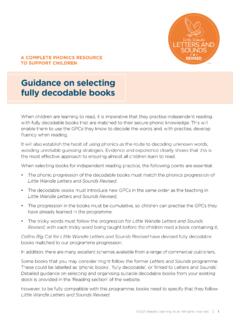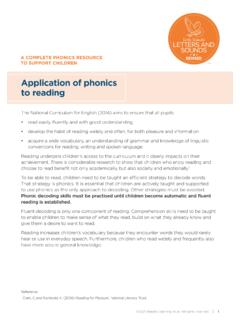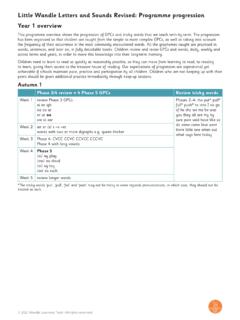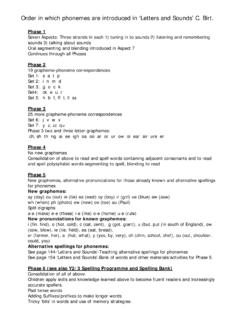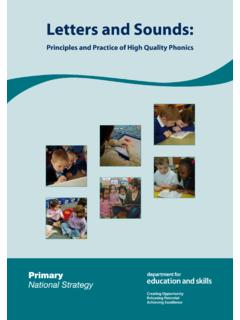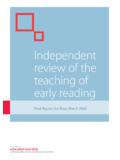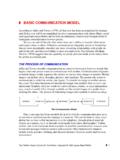Transcription of Glossary of Little Wandle Letters and Sounds Revised ...
1 A COMPLETE PHONICS RESOURCE. TO SUPPORT CHILDREN. Glossary of Little Wandle Letters and Sounds Revised terminology Adjacent consonants Two or more consonants that come together in a word without any intervening vowel or vowels (for example, d-r' in drop', s-t-r' in strap'). Adjacent consonants do not constitute a discrete unit of sound and are read by blending the individual consonant phonemes involved. Alien words A child-friendly term for pseudo-words'. Alphabetic code The relationship between the Sounds that can be identified in speech (phonemes) and the Letters used to represent them in writing (graphemes). Alternative pronunciation A different way of pronouncing a grapheme. For example, the Letters ow' can represent the Sounds /ow/ as in crown' and /oa/ as in snow'. Alternative spelling A different way of spelling a phoneme. For example, the sound /w/ can be represented in writing by w' as in wave' and wh' as in what'.
2 Blend To combine individual phonemes into a whole word, working all the way through from left to right. Once the GPCs involved have been learned, blending is the key process involved in reading words effectively. It is a skill that needs extensive practice. Practice in oral blending is very helpful, both before and during the process of learning to read. It is important to understand that blending Sounds into a word is not simply a matter of saying them more quickly, nor of mixing them together like paint. Phonemes need to be joined into one continuous stream of sound to make a spoken word. Extensive practice, following teacher modelling, is the key. 2021 Wandle Learning Trust. All rights reserved. 1. Catchphrase A type of mnemonic in the form of a memorable (often funny) phrase. Catchphrases are generally used in this programme to help children remember some of the later GPCs learned, where a picture alone might not give enough of a hook'.
3 Chunk it up To break up a longer word and read it one part (chunk) at a time, to avoid being overwhelmed and to ease the process of blending. Compound word A word made by joining two individual words together, for example, houseboat' is house'. + boat'. Digraph A grapheme using two Letters to represent one phoneme. With children, we frequently reinforce it with the mantra two Letters , one sound '. At the appropriate stage, it is useful for children to learn to use the term and to understand what it means. Fluency The ability to read accurately with speed and expression. Fluent readers read words automatically without needing to decode. It is at this point that we see them able to focus on comprehension and make sense of what is being read. Formation phrase A memorable phrase used to support the children in forming the letter correctly using directional vocabulary, such as down', up', across' and over'.
4 Under the snake's chin, slide down and round its tail. GPC. This stands for grapheme phoneme correspondence, the sound letter relationship between each element of the alphabetic code. Written English is quite complex and does not have one-to-one grapheme phoneme correspondence. The same phoneme can be represented by different graphemes in different words, and the same grapheme can represent different phonemes in different words. To ensure learning is systematic, and to avoid cognitive overload, this programme generally teaches one fairly common grapheme representation of each phoneme first. Alternative spellings of the same phoneme, and alternative pronunciation of the same grapheme are usually taught later, mostly in Phase 5. 2 2021 Wandle Learning Trust. All rights reserved. Grapheme A letter or group of Letters used to represent a particular phoneme when writing.
5 With children, we sometimes call this a sound written down', although, as with phoneme', it is helpful for children to learn to use the correct term from the beginning. The way graphemes are used to represent phonemes in our written language is known as the alphabetic code'. Group reading practice A group reading session where the children read alongside an adult from books containing known GPCs and tricky words, and have the opportunity to apply and practise their knowledge. The children should be able to access these books with 90% accuracy. (Also known as teaching reading with books'.). Grow the code To systematically and incrementally teach additional GPCs so that the range of words children can read continually extends. Homograph Homographs are words that have the same spelling but different meanings, for example, pen' (writing implement) and pen' (animal enclosure).
6 Homophone Homophones are words that have the same pronunciation but different spellings or meanings, for example, prey' and pray'. Mnemonic Any simple device used to assist memory. In this programme, it is a combination of an engaging picture with a letter and is used as a hook' to help children remember a particular GPC when they first learn it. Multi-syllable word A word with more than one syllable. Syllables are easy to recognise when words are spoken, but hard to distinguish in printed words until you know how to say them. The best way for children to learn to recognise syllables is to count (or clap) them when reciting known rhymes, songs, and so on. Oral blending A technique for the early practice of blending. The teacher articulates each phoneme in a word separately, in order, and children respond by saying the whole word aloud. Alternatively, they can be asked to blend the word silently and show they have done so by responding with some action, for example, touching their head, after the teacher has pronounced the separate phonemes in the word head'.
7 Such practice is valuable both before and during the early stages of learning to read. (Also known as sound -talk'.). 2021 Wandle Learning Trust. All rights reserved. 3. Orthographic store Children learn to read by first sounding and blending words, and then reading them straight off', without overt sounding and blending. Once this has been practised sufficiently, recognition of these words becomes automatic and they are held as an orthographic store in a highly specialised area of the brain that expert neurologist Stanislas Dehaene calls the brain's letterbox'. This orthographic store, and the instantaneous recall it enables, is the basis of fluent reading. It is important to remember that the orthographic store is most effectively built up through extensive practice of the sounding blending reading process, which establishes the necessary neural pathways, not through trying to memorise countless whole words.
8 Overt blending aloud sound -talking aloud every phoneme in turn before blending them together to form the word. Phoneme The smallest unit of sound that can be identified in words. We sometimes simply call this a sound ', although it is helpful for children to use the term phoneme' from the beginning of our programme. (Note: We do not usually notice discrete Sounds in words. We deliberately separate them out so that children can learn how our writing reading system works. Children are first helped to identify the separate Sounds in words through oral blending and segmenting, and this is reinforced as they begin to work through our systematic synthetic phonics programme.). Phonetically plausible Comprising grapheme phoneme correspondences that can be found in English words, even if they are not correct spellings of the (or any) actual word, for example, thor'. instead of thaw'.
9 Phonics screening check A statutory national assessment in England, conducted internally by schools towards the end of Year 1. Its sole purpose is to determine whether a child can phonically decode single words to an annually predetermined national standard. Phonics The method by which we teach children to read by recognising the connections between the Sounds of spoken words (phonemes) and the Letters that are used to write them down (graphemes). Point and sweep A technique for reinforcing the process of sounding and blending involving the teacher pointing to each phoneme in a word, in sequence from left to right, and then sweeping a finger below the word, again from left to right, to indicate the blending. It can be used with the teacher and/or children vocalising each stage, or as a reinforcement to silent sounding and blending as children become more confident. 4 2021 Wandle Learning Trust.
10 All rights reserved. Prefix A recognisable unit of language added to the beginning of a word to change its meaning. For example, rewrite' is write' with re ' added at the beginning, so re ' is the prefix. Examples of other common prefixes are un ', dis ', sub '. Prefixes usually carry a particular meaning, whatever word they are applied to. Prosody The rhythmic and intonational aspect of speech that manifests as expressive reading. It comprises timing, phrasing and intonation, and helps to convey meaning and add life' to reading. Pseudo-words Simple, phonetically plausible words' that don't actually occur in the English language; used (as in the Phonics screening check) to assess whether a child can correctly read a word they haven't seen before, using phonic decoding; use should be confined to assessment. Reading The process of looking at written symbols and getting meaning from them making meaning from print.
